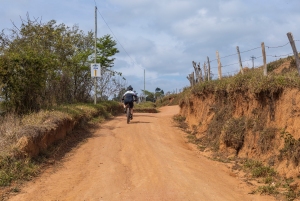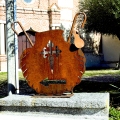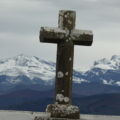Brazil is often described through its contrasts: tropical forests and megacities, Indigenous heritage and colonial legacies, rhythmic celebrations and everyday struggles. But the country is also home to interior paths—routes not only across land, but into memory, identity, and intention. One of the most significant among them is the Caminho da Fé (Path of Faith), a long-distance pilgrimage that culminates in the city of Aparecida, home to one of Latin America’s most visited sanctuaries.
Aparecida and Its National Symbol
Located in the state of São Paulo, the city of Aparecida hosts the Santuário Nacional de Nossa Senhora Aparecida, the largest Marian shrine in Latin America. Its origins are linked to a small clay figure retrieved from the Paraíba do Sul River by fishermen in 1717. Over time, this image became a powerful symbol for many Brazilians—associated with protection, especially for the enslaved and marginalized, and widely embraced across social classes.
Declared Brazil’s official patron in 1930, the figure’s importance grew throughout the 20th century. A major milestone came in 1980 with the consecration of the new basilica during a papal visit. Its massive nave and plaza reflect its scale: more than 12 million people visit Aparecida annually, arriving by road, bike, and increasingly, on foot.
A Pilgrimage Inspired Abroad, Built at Home
The Caminho da Fé emerged in the early 2000s, sparked by Almiro José Grings after his experience walking the Camino de Santiago in Spain. Moved by the structure and sense of shared journey he encountered, Grings returned to Brazil with the idea of creating a similar pilgrimage—one that offered wayfinding support, basic lodging, and a coherent route toward a destination already central in Brazilian devotion.
With backing from local supporters, he founded the Associação dos Amigos do Caminho da Fé, and in 2003, the route officially opened. The initial segment ran from Águas da Prata, in the interior of São Paulo, to Aparecida. Since then, the Caminho has expanded into a vast network of interconnected paths—over 2,000 kilometers long—crossing more than 70 municipalities in São Paulo and Minas Gerais.

The Main Route: From Águas da Prata to Aparecida
The most established route spans roughly 318 kilometers, beginning in Águas da Prata and winding through the Serra da Mantiqueira before reaching the sanctuary. Most walkers complete the journey in 12 to 14 days. The terrain varies considerably: forest paths, rural roads, gravel tracks, and stretches of asphalt. While physically demanding, the walk is accessible to most people in good health who prepare adequately.
The landscape changes frequently—cool highlands, dense vegetation, open farmland, and hilltop views—and each day presents a different rhythm. Nights are spent in small towns and rural districts, where local accommodations cater to pilgrims. These range from formal inns and converted homes to parish buildings offering basic lodging.
Notable Stops and Local Culture
Key towns along the route include:
- Andradas: Known for vineyards and artisanal wines
- Inconfidentes: With a colonial past and strong craft traditions
- Borda da Mata: Renowned for its textile production and hospitality
- Luminosa: A rural hamlet with an atmosphere of preserved quiet
- Campos do Jordão: A highland resort with alpine-style architecture
- Pindamonhangaba: One of the final urban centers before Aparecida
In each place, pilgrims find infrastructure—but more importantly, a social fabric that supports the journey. The Caminho has fostered an informal but reliable network of volunteers, hostel operators, and local guides, whose support often defines the experience more than any physical marker.
Orientation and Pilgrim Credentials
The route is marked with yellow arrows, modeled after the Spanish Camino. These guide walkers across intersections, through fields, and into remote stretches—making the use of GPS largely unnecessary. Pilgrims carry a credencial (passport), stamped at lodgings, eateries, and local sites along the way. Upon reaching Aparecida, those who have completed at least the final 100 kilometers on foot or by bicycle may request a certificate of completion.
The Black Virgin of Brazil: Pilgrimage, Slavery, and National Myth
Alternative Routes and Access Points
While Águas da Prata remains the most traditional departure point, the Caminho da Fé includes multiple branches that connect towns across interior Brazil to the central axis of the route. These allow walkers to choose according to physical condition, time, or personal interest:
- Paraisópolis to Aparecida: ~130 km (~5 days)
- Campos do Jordão to Aparecida: ~55 km (~2 days)
- São Simão or Cravinhos to Aparecida: 500–600 km (20–30 days)
The official website provides downloadable maps, route profiles, accommodation listings, and logistics. Some travelers choose guided support services, including luggage transport and medical access, especially helpful for older adults or first-time long-distance walkers.
Preparation and Practicalities
Though not requiring elite fitness, the Caminho da Fé demands planning. Prior walking experience is strongly advised, especially over mixed terrain. Recommendations include:
- Training walks with full gear
- Proper footwear and moisture-wicking socks
- Lightweight backpack (ideally 6–8 kg)
- Trekking poles and rain protection
- Layered clothing for significant temperature swings in highland regions
Daily expenses—including meals, lodging, and basic supplies—average around R$100 (~€20). Costs may be lower for those who cook, accept volunteer lodging, or camp occasionally.
The Inner Dimension of Walking
Beyond its physical path, the Caminho da Fé offers a kind of internal recalibration. Days unfold at walking pace, without screens or tight schedules. Many walkers begin with a clear motivation—grief, gratitude, decision-making—but find that the rhythm of the trail reshapes priorities. Shared meals, impromptu conversations, and quiet evenings form the social fabric of the walk.
Pilgrims of different beliefs and backgrounds often travel side by side. The Caminho fosters unlikely connections: between locals and foreigners, between youth and elders, between those seeking silence and those seeking answers. For some, the walk becomes a space for personal integration. For others, it remains simply a journey that leaves a lasting imprint.
Arrival and Continuation
The final descent toward Aparecida is emotionally charged. From hilltops, the towers of the sanctuary come into view—marking a destination, but not an endpoint. Upon arrival, walkers often gather at the pilgrim reception center, share stories, receive certificates, and rest. Some attend services or visit the old basilica and museum. Others sit quietly, taking in what the road has brought.
The experience doesn’t conclude in Aparecida. Like all long walks, the Caminho da Fé carries forward in those who have walked it—through changed habits, renewed perspectives, or enduring friendships. The path itself continues to evolve, shaped by those who walk, support, and sustain it.




